Abstract
The growing emphasis on controlling sulfur-containing compounds in fuel oils has driven the development of numerous desulfurization technologies. Among these, catalytic oxidative desulfurization (CODS) has garnered considerable research interest due to its exceptional capability to efficiently remove refractory sulfur compounds, particularly dibenzothiophene (DBT), under relatively mild reaction conditions. However, the widespread application of CODS has been hindered by the high cost and complex preparation processes of the catalysts. To enhance the practical potential of CODS, in this study, a novel Zr@AC catalyst was developed by a facile “solution impregnation + high-temperature calcination” strategy, where zirconium species were effectively supported on activated carbon. Experimental results demonstrated that under optimized conditions of 0.1 g catalyst dosage, 2.0 O/S ratio, reaction temperature 100 °C and reaction time 50 min, the Zr@AC-mediated CODS system achieved a remarkable desulfurization efficiency of 97.24% for DBT removal. The removal efficiency of DBT increased by 9.0% compared with non-catalytic systems. The characterization techniques revealed that the Zr@AC catalyst possesses a hierarchically rough surface morphology, high specific surface area, abundant active sites, and distinctive Zr-O functional groups. Kinetic analysis indicated that the oxidation process follows second-order reaction kinetics. Furthermore, the catalyst maintained over 95% desulfurization efficiency after five consecutive regeneration cycles, confirming that the prepared catalyst has the exceptional recyclability and operational stability.
1. Introduction
During burning, organic sulfur molecules in fuel oil convert to harmful sulfur oxides, including sulfur dioxide (SO2) and sulfur trioxide. These compounds are some of the main contributors to photochemical smog [1] and negatively impact vehicle performance and the environment [2]. Furthermore, prolonged exposure to acidic gases containing hydrogen sulfide can cause hypoxia, oxidative stress, and neuroinflammation, which can result in respiratory and neurological damage [3]. High concentrations of sulfur compounds released into the air can also be hazardous to human health. To reduce the sulfur compounds in vehicle exhaust emissions, China, Europe, and the United States have established guidelines setting the maximum permissible sulfur concentration in gasoline at 10 ppm [4]. Thiophene is a significant component of fuel oil and accounts for almost 90% of the sulfur compounds in gasoline. More than 70% of the thiophene group compounds is difficult-to-degrade dibenzothiophene (DBT) [5]. Several methods, including adsorption, oxidation, and liquid-phase absorption, are often employed for desulfurization of fuel oil [6]. As an alternative to hydrodesulfurization, adsorption desulfurization can remove sulfur compounds from oil by immobilizing the pollutants inside an adsorbent, adsorbing them using various materials under mild conditions. Carbon nanomaterials [7,8], metal-modified activated carbon (AC) [9], porous graphene [10], and metal–organic skeletons [11,12] are known adsorbent materials. This method is currently a primary area of research and development for removal of sulfur compounds from fuel oils [13]. However, this method has limitations, including secondary contamination, high treatment costs, and inadequate treatment effects. In the liquid-phase absorption method, which is a wet desulfurization technology, SO2 in flue gas is absorbed and transformed into other compounds by a liquid absorbent containing alkaline substances [14]. Although the liquid absorption method has a great desulfurization impact, there are still issues, including high operational and investment costs and the challenge of handling waste liquid after absorption [15]. One of the most widely used oxidation techniques in industry is hydrodesulfurization (HDS), in which high temperature and pressure are primarily used to remove sulfide from oil oxidized by H2. However, this technology is limited by high energy consumption, high operating requirements, easy production of secondary pollutants, and removal of sulfur compounds because of the poor effect of DBT [16].
To rectify the deficiencies of oxidative desulfurization (ODS) and enhance sulfide extraction from oil, researchers have developed catalytic oxidative desulfurization (CODS) technologies. Metal-loaded catalysts exhibit superior catalytic efficacy in the desulfurization process because of their highly active sites, porous architectures, and distinctive electronic configurations [17]. Teimouri et al. synthesized mesoporous silica-supported molybdenum/vanadium catalysts by impregnation for catalytic oxidation elimination of DBT from oils, attaining favorable removal outcomes [18]. The CNC@PIL@POM catalysts formulated by Yang et al. showed exceptional catalytic efficacy in simulated desulfurization trials, achieving complete conversion of benzothiophene (BT), DBT, and 4,6-dimethyl dibenzothiophene (4,6-DMDBT) [19]. Nejati et al. created Co4-POM@APTES-(Fe3O4/GO) nanocomposites that effectively eliminated DBT, BT, and 4,6-DMDBT from simulated fuels within 30 min while maintaining excellent catalytic performance [20]. Among catalyst manufacturing methods, the utilization of AC as a support and the incorporation of active compounds have been extensively researched [21,22]. Meng et al. [23] effectively synthesized Cu-Fe oxide catalysts (CuFeNaAC-5) utilizing Na2CO3-modified AC as the support through the impregnation-calcination technique. Upon optimizing the loading of Cu-Fe oxides, the catalyst demonstrated a peak sulfur capacity of 430.09 mg/g at ambient temperature, surpassing the desulfurization efficacy of other documented activated catalysts. Saleh et al. [24] synthesized Mo and Co supported on AC catalysts (ACMoCo) and unloaded MoCo catalysts. The results in studies using DBT model oil with 500 ppm sulfur as the first HDS substrate indicated that ACMoCo demonstrated superior HDS performance. Under identical reaction conditions, the sulfur removal efficiency of ACMoCo reached 98.8%, markedly surpassing that of MoCo (73.5%).
The selective deposition of metallic species onto support matrices and engineered production of AC-supported catalysts are innovative methods for enhancing CODS technologies [25]. Because of their unique properties, zirconium ions can be functionalized on material surfaces and utilized in environmental pollution remediation strategies [26], including incorporation into modified zeolites [27], molecular sieves [28], and metal–organic frameworks [29], indicating that zirconium ions can bond with various materials to eliminate target pollutants. Nevertheless, a review of the current literature indicates that research on the loading of zirconium ions onto AC for the catalytic oxidative elimination of sulfides from fuel oils is scarce. Furthermore, the mechanism of the role of zirconium ions in catalytic oxidation desulfurization still requires further investigation. In this study, zirconium ions were utilized as the active component and AC was used as the carrier to formulate catalysts for the catalytic oxidative elimination of DBT, a representative refractory sulfide in fuel oil. The CODS efficacies of the catalysts were examined to elucidate their mechanisms in the catalytic oxidation process and to offer a technical reference for the extraction of sulfides from fuel oil.
2. Materials and Methods
2.1. Reagents Preparation
In this study, analytically pure DBT (Shanghai Macklin Biochemical Co., Ltd., Shanghai, China) was used as the simulated sulfide and dissolved in octane (Shanghai Yi’en Chemical Technology Co., Ltd., Shanghai, China) (simulated gasoline) for the CODS tests. Before the experiment, 1.452 g of DBT was dissolved in a minimal quantity of n-octane, transferred to a 250 mL volumetric flask, and adjusted with n-octane to the calibration mark to create an n-octane stock solution with a sulfur concentration of 1000 ppm. For these studies, the simulated oil was diluted to a sulfur concentration of 500 ppm using the dilution multiplier method, and a Zr4+ solution was prepared by dissolving a precise quantity of zirconium nitrate [Zr(NO3)4-5H2O] (Shanghai Macklin Biochemical Co., Ltd., Shanghai, China) in ultrapure water.
2.2. Preparation of Zr@AC
The material preparation procedure primarily relied on prior research conducted by our group [30], and is summarized as follows: The acid- and alkali-pretreated AC powder was submerged in a 7% (wt%) Zr4+ solution for 9.0 h. After filtration, the obtained solid sample was dried at 90 °C, followed by calcination at 500 °C for 5.0 h under an air atmosphere to achieve stable loading of metal ions onto AC. Then, the calcined materials were pulverized to produce the Zr-modified AC catalyst, Zr@AC.
2.3. Catalytic Oxidative Desulfurization Experiment
Subsequently, 20 mL of the formulated model oil (sulfur content: 500 ppm) was added to a three-necked flask. Then, 0.05–0.25 g of Zr@AC catalyst and cyclohexanone peroxide (CYHPO, Shanghai Yi’en Chemical Technology Co., Ltd., Shanghai, China) oxidant were incorporated, maintaining an O/S molar ratio of 0.5–6.0. To prevent liquid evaporation, a condenser was affixed to one neck of the three-necked flask, whereas the other two necks were sealed. The three-necked flask containing the mixture was positioned in a constant-temperature oil bath, and the reaction system temperature was maintained between 50 °C and 120 °C for 20–60 min. Subsequently, the filtered simulated oil was transferred to a separatory funnel and extracted twice with N,N-dimethylacetamide (DMAC, Shanghai Yi’en Chemical Technology Co., Ltd., Shanghai, China) at an oil-to-solvent volume ratio of 1:0.8 and next at a ratio of 1:0.6. After the two extractions, the remaining DBT content was identified via gas chromatography following the passage of the top oil phase through a 0.22 μm organic filter membrane. The ideal parameters for catalytic oxidation were established based on the elimination rate of DBT, considering various catalyst and oxidant dosages (O/S ratio) and reaction temperatures and durations.
2.4. Material Characterization
The specific surface area, pore size, and N2 isothermal adsorption–desorption curves of Zr@AC were analyzed by a specific surface area and pore size analyzer (BET, JW-BK200C, Beijing Jingwei Gao Bo Science and Technology Co., Ltd., Beijing, China). A suitable quantity of dried Zr@AC was placed in a sample tube, and scanning electron microscopy (SEM; JSM-7900F, Nippon Electron Co., Ltd., Tokyo, Japan) and the associated X-ray spectrometry (EDS) were used to examine the surface morphology and microzone composition of the materials. Physical phase analysis of the materials was conducted utilizing an X-ray diffractometer (XRD; X’Pert3 Powder, Panacor, The Netherlands) operating at a voltage of 40 kV, a current of 30 mA, and a scanning range of 2° < 2θ < 60° and interval of 0.02°. The results were analyzed using Jade 6.5 software. The surface functional groups of the materials were examined using Fourier transform infrared absorption spectrometry (FTIR; NICOLET iS10, Thermo Fisher, Waltham, MA, USA). The dried samples were ground with KBr into a powder at a mass ratio of 1:100 at room temperature and analyzed within a wavelength range of 450–4000 cm−1.
2.5. Detection and Analysis of Sulfur
A gas chromatograph (6890N, Agilent Technologies, Inc., Santa Clara, CA, USA) was used to determine the sulfur content of the samples. The testing parameters were as follows: FPD detector, DB-1701 column (30 m × 250 μm × 0.25 μm); set temperature of 250 °C; inlet temperature of 250 °C, pressure of 11 psi; high-purity nitrogen (99.99%) as the carrier gas, flow rate of 2.0 mL/min; and initial column temperature of 100 °C, maintained for 5 min at 5 °C. The initial column temperature, maintained for 5 min, was then increased to 220 °C at 10 °C/min and sustained for another 5 min. The hydrogen, air, and tail gas flow rates were 30 mL/min, 350 mL/min, and 30 mL/min, respectively.
The efficacy of catalytic oxidation for desulfurization was assessed by the sulfur removal rate η, which was determined as follows:
where C0 and Ct represent the S concentration of the simulated oil before and after the reaction (ppm), respectively.
η = [(C0 − Ct)/C0] × 100%
Recovery is an important economic indicator of oil refining technology. Irrespective of the desulfurization technology employed, a specific quantity of oil is lost upon the completion of processing. Consequently, in this investigation, the oil recovery rate, denoted as ε, was determined as follows:
where m0 and m represent the mass of the simulated oil before and after the reaction (g), respectively.
ε = (m0 − m) × 100%
To guarantee the stability and trustworthiness of the data, three parallel samples were established in each experimental session and examined by computing the mean values.
3. Results and Discussion
3.1. Desulfurization Effect of Different Desulfurization Systems
To assess the efficacy of the CODS using Zr@AC, three desulfurization systems were devised: (a) DBT was extracted solely with DMAC, (b) DBT was oxidized by CYHPO and extracted with DMAC without the inclusion of Zr@AC, and (c) DBT was oxidized by CYHPO and subsequently extracted with DMAC with the incorporation of Zr@AC. The experimental results are listed in Table 1.

Table 1.
Desulfurization efficiency of different desulfurization systems.
Because of the high polarity of the extractant DMAC, DBT exhibited superior solubility in DMAC compared to that in n-octane. Consequently, DBT in n-octane could be partially transformed in DMAC upon extraction, yielding a desulfurization rate of 85.70%. This indicates that the extraction could partially eliminate DBT from the oils. In the presence of CYHPO, DBT in the oil was initially oxidized to sulfone or sulfoxide [31], achieving a desulfurization rate of 88.19% by extraction, indicating that “oxidation + extraction” can further reduce the DBT concentration in the oil. Introducing Zr@AC into the oxidation system substantially augmented the oxidizing capacity of CYHPO, resulting in a significant increase in the desulfurization efficiency, which reached 97.04%. This suggests that Zr@AC positively contributed to the CODS reaction. To investigate the catalytic oxidation efficacy and mechanism of the synthesized materials for DBT, comprehensive analyses were conducted.
3.2. Influence of Reaction Conditions on the Effectiveness of CODS
3.2.1. Effect of Catalyst Dosage on Desulfurization Performance
The catalytic oxidation performance of the produced Zr@AC material was evaluated by investigating the impact of catalyst dosage on CODS efficiency. Figure 1 illustrates that augmenting the Zr@AC dosage from 0.05 g to 0.1 g markedly improved the DBT elimination effectiveness from 88.29% to 96.46%. This enhancement might be ascribed to increased catalyst loading, which promotes the formation of oxidizing peroxy groups from CYHPO, thereby augmenting the desulfurization efficiency [31]. Because of the substantial adsorption capability of the Zr@AC support, an increase in its loading offers additional sites for enrichment of DBT molecules while simultaneously expanding the population of catalytic active sites available for radical production. This duality can lead to a synergistic effect, wherein the adsorption function preconcentrates DBT molecules in close proximity to the catalytic centers, thereby significantly enhancing the efficacy of oxidative degradation. Both mechanisms thus concertedly contribute to the overall enhancement of the DBT removal rate [32]. Nonetheless, augmenting the catalyst dosage to 0.25 g yielded no significant enhancement in DBT elimination. The saturation effect presumably occurred because the oxidant (CYHPO) concentration remained constant. The extra catalyst could not produce new peroxy groups, rendering the surplus catalyst ineffective. The model oil recovery rate significantly decreased with increasing catalyst loading (Figure 1), which is likely attributable to the competing adsorption of DBT and n-octane (a model oil component) by the catalyst [33]. Based on these observations, 0.1 g of Zr@AC was considered and used as the best dosage for further tests (unless stated otherwise).
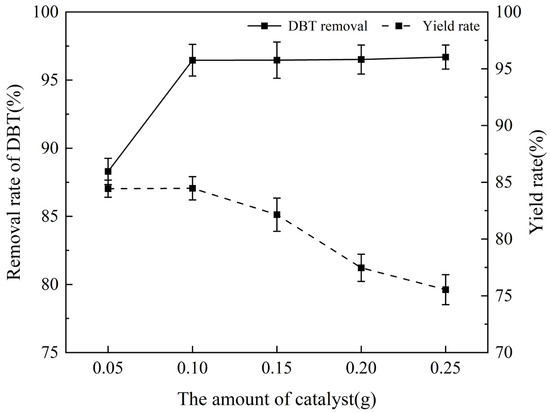
Figure 1.
Effect of catalyst dosage on desulfurization efficiency (experimental conditions: S concentration = 500 ppm, O/S = 2, reaction time = 40 min, reaction temperature = 100 °C, solution volume = 20 mL).
3.2.2. Effect of Oxygen-Sulfur Ratio (O/S) on Desulfurization Performance
Figure 2 illustrates the impact of varying the O/S ratio on the catalytic oxidation of DBT and oil recovery. It shows that when the O/S ratio was increased from 0.5 to 2.0 with the Zr@AC catalyst the desulfurization efficiency for DBT increased from 88.93% to 96.46%. Upon further increasing of the O/S ratio from 2.0 to 6.0, the desulfurization effectiveness of the system exhibited only a marginal enhancement. In CODS experiments, the oxidant predominates, and an increase in the oxidant CYHPO can generate additional peroxy groups with oxidizing capacity, effectively eliminating substantial quantities of DBT. However, an excessive amount of oxidant may render some of the generated peroxy groups inactive before they can exert their oxidizing effect [34]. The Zr@AC catalyst promotes favorable homolysis of cumyl hydroperoxide (CYHPO) to yield potent oxygen-centered radicals, establishing a highly effective oxidative cycle. Nonetheless, at elevated concentrations, a competing non-catalytic bimolecular interaction between CYHPO molecules becomes significant. This alternative route involves a four-membered ring transition state and results in a dipolar decomposition mechanism, furnishing dimethylphenylcarbinol and molecular oxygen as the principal products and bypassing radical formation entirely. Concurrently, any radicals produced homolytically are susceptible to interception by the excess CYHPO, which functions as a radical trap and instigates chain termination events, ultimately compromising the global oxidative efficiency. Consequently, in CODS, the impact of oxidation does not increase with increasing oxidant concentration. The experiment revealed that the oil recovery in the catalytic oxidation system of Zr@AC remained at approximately 85%, suggesting that the system exhibited an oxidizing capability solely for DBT. This reduction in oil recovery may be attributed to the adsorption effect of Zr@AC, indicating that the catalytic oxidation system possesses enhanced selectivity for sulfur removal. To enhance the study an O/S molar ratio of 2.0 was employed as the best oxidant dosage for all subsequent trials.
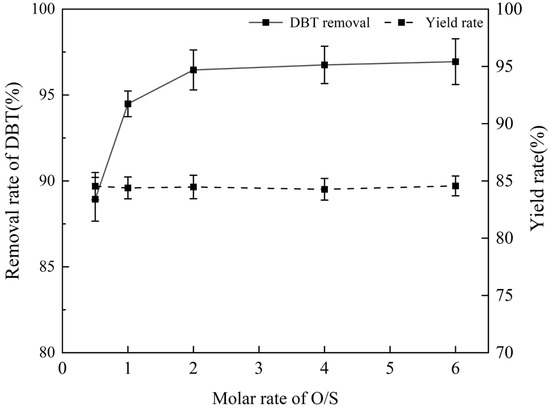
Figure 2.
Effect of Oxygen-Sulfur ratio (O/S) on desulfurization efficiency (experimental conditions: catalyst = 0.1 g, S concentration = 500 ppm, reaction time = 40 min, reaction temperature = 100 °C, solution volume = 20 mL).
3.2.3. Effect of Reaction Temperature on Desulfurization Performance
Figure 3 illustrates the effect of temperature on the elimination of DBT. The desulfurization effectiveness of Zr@AC catalytic oxidation progressively improved with increasing reaction temperatures, achieving maximal DBT elimination at 100 °C. The accelerated molecular thermal movement due to the elevated temperature enhanced the catalytic efficacy of the Zr@AC catalyst for CYHPO [35], resulting in the formation of numerous peroxy-generated groups in CYHPO, which facilitated the effective removal of DBT. Nevertheless, when the temperature was increased from 100 °C to 120 °C, the DBT removal rate decreased, likely due to the decomposition of the oxidant CYHPO at excessively high temperatures [36]. Although high temperatures undeniably enhance the rate of radical formation, the resulting paramount local concentration drastically increases the probability of intermolecular collisions. Consequently, the system favors termination pathways by which radicals undergo mutual annihilation, thereby diverting them from productive chain propagation steps with DBT. This results in a reduced oxidant quantity and consequent impact on the efficacy of the CODS reaction. Furthermore, the recovery of the simulated oil was influenced by temperature and progressively diminished as temperature increased, likely due to the reduction in viscosity and enhancement of oil fluidity resulting from the elevated temperature [37]. Based on the aforementioned experimental results, 100 °C was designated as the optimal temperature for CODS in subsequent tests.
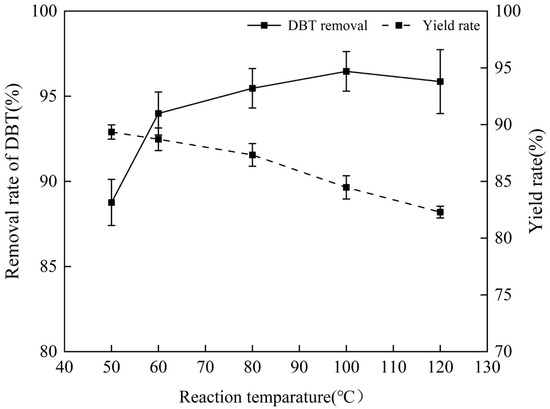
Figure 3.
Effect of reaction temperature on desulfurization efficiency (experimental conditions: catalyst = 0.1 g, S concentration = 500 ppm, O/S = 2.0, reaction time = 40 min, solution volume = 20 mL).
3.2.4. Effect of Oxidation Reaction Time on Desulfurization Performance
To examine the impact of reaction time on the CODS efficacy, five experimental groups with different reaction durations were established. The findings are illustrated in Figure 4. With increasing reaction time, the DBT elimination efficiency of Zr@AC increased significantly, reaching a peak of 95.24% at 50 min. A slight reduction in DBT elimination was observed beyond this period. This trend indicates that adequate time is necessary for the oxidant CYHPO to activate completely and produce reactive peroxy groups under catalytic conditions, thus improving the desulfurization efficiency. Prolonged reaction periods may cause quenching or degradation of the active peroxy groups, diminishing their efficacy and leading to reduced DBT elimination [31,38]. Simultaneously, the recovery rate of n-octane (the model oil component) decreased progressively with increasing reaction time (Figure 4). This reduction may have resulted from the synergistic effects of adsorption by Zr@AC and volatilization of n-octane during extended reactions. A time of 50 min was determined to be the best reaction time for subsequent CODS investigations.
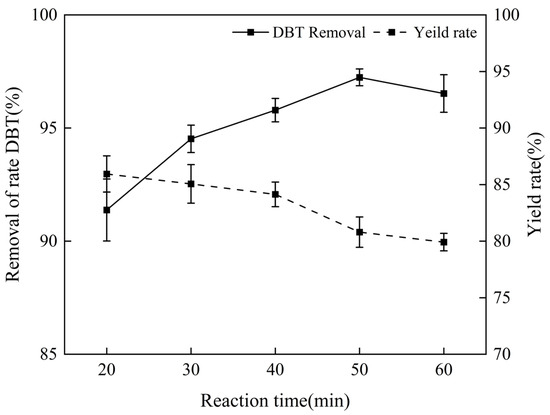
Figure 4.
Effect of reaction time on desulfurization efficiency (experimental conditions: catalyst = 0.1 g, S concentration = 500 ppm, O/S = 2.0, reaction temperature = 100 °C, solution volume = 20 mL).
3.2.5. Effect of Different Initial Sulfur Concentrations on Desulfurization Performance
The impact on the CODS of varying the initial sulfur concentration was examined, and the results are presented in Table 2. The residual sulfur content after the catalytic oxidation process increased with increasing initial sulfur concentration. The fixed quantities of the catalyst and oxidant in the reaction system limit their oxidizing capacity; thus, an increase in the sulfur content makes it more difficult for DBT to undergo catalytic oxidation, leading to higher residual levels of DBT in the system [39]. Increasing the sulfur concentration from 300 to 500 ppm enhances the concentration gradient driving force, accelerating sulfur species diffusion toward active sites. Molecular dynamics simulations confirm increased reactant collision frequency at higher concentrations, which overcomes mass transfer energy barriers [40]. The Zr@AC catalyst demonstrated superior degradation efficacy for elevated concentrations of DBT across the entire experimental spectrum, suggesting its suitability for the catalytic oxidation removal of oil products with high DBT concentrations.

Table 2.
Effect of different initial sulfur concentrations on CODS.
3.3. Characterization of Zr@AC
3.3.1. XRD Analysis
XRD examinations of Zr@AC were performed before and after the reaction to elucidate the mechanism of the catalyst action in the CODS. The findings are depicted in Figure 5. The Zr@AC sample displayed seven distinct ZrO2 peaks, at 26.94°, 29.14°, 31.22°, 34.58°, 35.76°, 49.83°, and 50.95°, which correspond to the (110), (−111), (111), (200), (002), (220), and (022) diffraction planes, respectively [30,41]. This study engineered atomic ZrO2 sites on the AC surface. Previous research has demonstrated the outstanding catalytic performance of ZrO2 [42], suggesting that the ZrO2 species in the Zr@AC catalyst likely serve as the active sites in the CODS reaction. These uniquely structured sites enhance catalytic activity, selectivity, and stability. Moreover, the XRD patterns of Zr@AC before and during the reaction exhibited substantial similarities with no appearance of new distinctive peaks. This discovery demonstrates that the structural integrity of Zr@AC is preserved throughout the catalytic process, confirming the exceptional stability of this catalyst system.
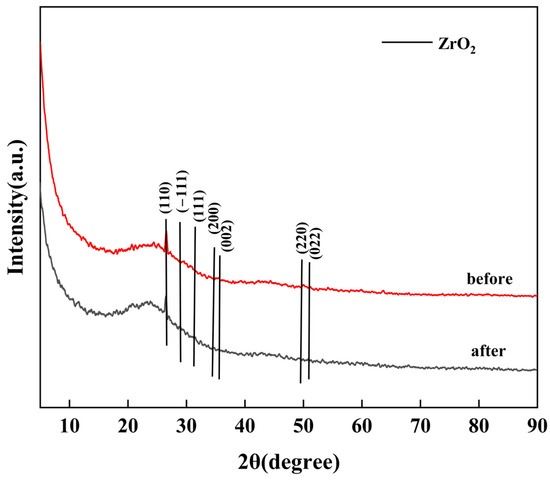
Figure 5.
XRD plot of Zr@AC.
3.3.2. FTIR Analysis
FTIR analysis was conducted on Zr@AC before and after CODS to examine the structural alterations of the catalyst (Figure 6). The distinctive absorption bands at 773.5 cm−1 and 774.5 cm−1 are attributable to the vibration modes of Zr-O [43], corroborating the XRD results. The spectrum indicates additional functional groups: broad bands at 3451.5 cm−1 and 3434.5 cm−1 (O-H stretching of adsorbed water) [44], sharp peaks at 2835 cm−1 and 2834.5 cm−1 (C-H stretching in -CH and -CH2 groups) [45], distinct absorptions at 1601.5–1605.5 cm−1 (C=C/C=O stretching vibrations) [46], and peaks at 1363–1365 cm−1 (C-OH bending vibrations) [47]. The spectral characteristics validate the existence of several active sites in Zr@AC that enable adsorption and catalytic oxidation mechanisms. The catalytic oxidative desulfurization process commences with multi-modal adsorption of DBT onto the Zr@AC surface. Initially, the DBT molecules are physisorbed onto the hydrophobic surfaces and within the pores of the AC aromatic framework via π-π interactions and van der Waals forces [48]. Subsequently, oxygen-containing functional groups on the AC surface further anchor the DBT molecules through hydrogen bonding. Concurrently, Zr4+ Lewis acid sites achieve chemisorption and pre-activation by engaging in specific coordination with the sulfur atom of DBT. Following adsorption, the neighboring Zr-O bonds efficiently activate CYHPO, generating oxygen-centered radicals that promptly oxidize the pre-concentrated DBT molecules in proximity. Throughout this process, the C=O and C-OH functional groups on the AC support significantly enhance the catalytic efficiency and long-term stability of the Zr active centers via electronic effects and synergistic interactions. Additionally, the characteristic peaks of Zr@AC exhibited noticeable perturbations, which serve as evidence that its functional groups played an active role in the adsorption mechanism. The consistent band locations before and after the reaction indicate the remarkable structural stability of the catalyst under CODS conditions.
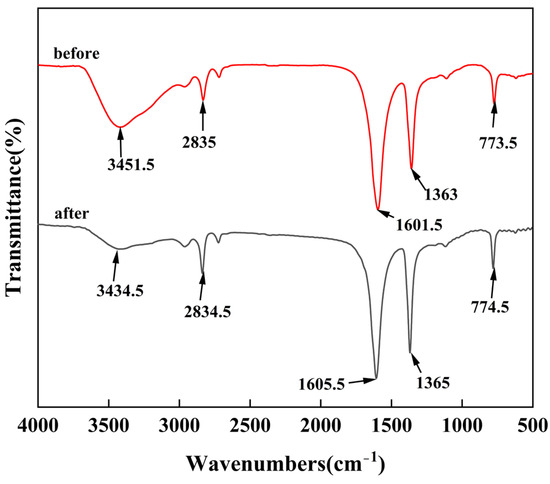
Figure 6.
FTIR plot of Zr@AC.
3.3.3. SEM Analysis
The surface morphology of the produced Zr@AC catalyst was examined using SEM, as shown in Figure 7a. The material has a textured morphology with particle characteristics, indicating an enhanced surface area and accessibility to active areas. This structural feature increases the adsorption capacity for sulfur-containing compounds (e.g., DBT) within surface folds and pores, whereas the catalytic surface encourages the formation of peroxide radicals from the oxidizing agent CYHPO, thus aiding DBT elimination. Figure 7b shows the EDS spectrum of Zr@AC, validating the effective integration of the zirconium species into the AC matrix. This outcome further confirms the presence of Zr-O functional groups on the catalyst surface, as previously determined by XRD and FTIR analyses.
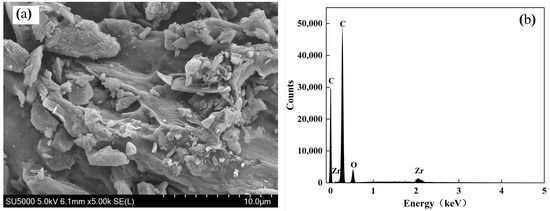
Figure 7.
SEM (a) and EDS (b) images of Zr@AC.
3.3.4. N2 Adsorption–Desorption and BET Analysis
As shown in the nitrogen adsorption–desorption isotherms in Figure 8, Zr@AC belongs to the type IV nitrogen adsorption isotherm with a distinct hysteresis loop, with a maximum adsorption (desorption) capacity of 461.058 cm3/g, and an average adsorption pore diameter of 2.859 nm. The BET analysis results show that the specific surface area, the total adsorption pore volume and the total micropore volume of Zr@AC are 995.084 m2/g, 0.663 cm3/g and 0.4232 cm3/g, respectively. This indicates that the prepared Zr@AC is a microporous material and can play an important role in catalytic oxidative desulfurization by taking advantage of its own characteristics.
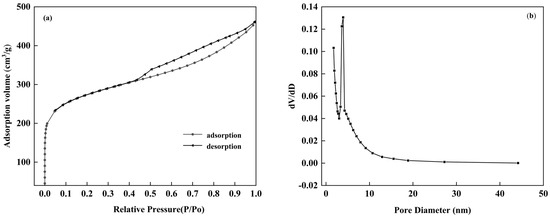
Figure 8.
Nitrogen isothermal adsorption–desorption curves (a) and pore size analysis (b) of Zr@AC.
3.4. Reaction Kinetics of Catalytic Oxidative Desulfurization
To investigate the desulfurization mechanism further, Equation (3) was employed to analyze the reaction kinetics of the catalytic oxidation process [49]:
When n = 1, indicating that the CODS is a single-stage reaction, the kinetic equation for the one-stage reaction can be simplified as follows:
When n = 2, indicating a secondary reaction, the kinetic equation can be reduced to the following equation:
where k is the reaction rate constant (min−1), t is reaction time (min), C0 is initial sulfur concentration (ppm), C(t) is sulfur concentration at time t (ppm), n is the reaction order (dimensionless), and a is a pre-exponential factor (concentration1−n·min−1).
The kinetics study, illustrated in Figure 9 and Table 3, indicates that the CODS process adheres to second-order kinetics (R2 = 0.9979), which show a markedly superior alignment with this model than first-order kinetics. This signifies the dual dependence of the reaction rate on DBT concentration and catalyst dosage. An extended reaction time improves the interaction between DBT and Zr@AC, resulting in the gradual adsorption of sulfur compounds onto the catalyst surface. Subsequently, nucleophilic substitution occurs with the peroxide radicals produced by CYHPO activation [50]. These discoveries correspond to the findings of Saleh et al., who documented enhanced desulfurization efficiencies with elevated metal loadings on AC catalysts [51]. The enhanced kinetic performance under Zr@AC catalysis validates its elevated oxidation activity attributable to synergistic adsorption and catalytic conversion mechanisms.
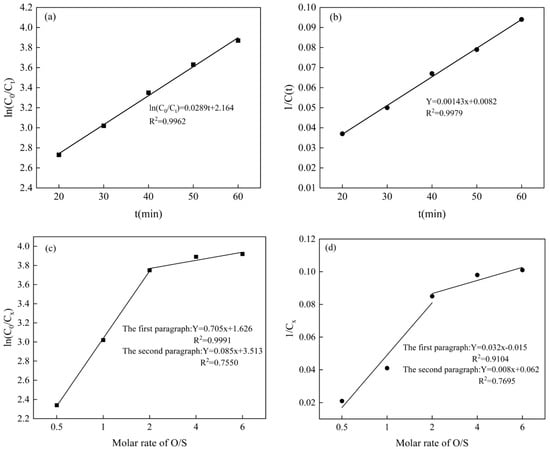
Figure 9.
Catalytic oxidation reaction kinetics: (a) Zr@AC-catalyzed DBT oxidation: Pseudo-First-Order kinetics. (b) Zr@AC-catalyzed DBT oxidation: Pseudo-Second-Order kinetics. (c) Effect of O/S molar ratio on the Pseudo-First-Order kinetics. (d) Effect of O/S molar ratio on the Pseudo-Second-Order kinetics.

Table 3.
Reaction kinetics simulation.
The kinetic fittings under O/S molar ratios are also performed. In the initial stage, the process exhibited characteristics of both the First-order and the Second-order kinetics, suggesting that the reaction likely follows a Langmuir-Hinshelwood mechanism, where the co-adsorption and subsequent surface reaction of DBT and CYHPO on the Zr@AC catalyst collectively govern the initial rate. As the reaction proceeds, the kinetic behavior transitions to a significantly slower first-order regime, indicative of control by diffusion or the availability of surface sites. This transition strongly indicates that the present catalytic oxidation process is a complex system that evolves from surface-reaction control to mass-transfer control, which highlights the pivotal role of the catalyst’s surface active sites and the importance of optimizing mass transfer efficiency for achieving highly effective deep desulfurization.
3.5. Catalyst Reuse Performance and the Performance Comparison
To investigate the cyclic reuse performance of the prepared material, under the conditions of 20 mL of simulated oil with a sulfur content of 500 ppm, catalyst amount of 0.1 g of Zr@AC, O/S ratio of 2.0, reaction temperature of 100 °C, and reaction time of 50 min, a desulfurization experiment was completed. The post-reaction simulated oil and catalyst were filtered and separated. The used catalyst was collected and washed five times with N, N-dimethylacetamide and anhydrous ethanol, respectively. After drying at 75 °C, the catalyst was reused in the CODS experiment. This process was then repeated. The CODS results are shown in Figure 10. It shows that the catalytic oxidative performance of Zr@AC gradually decreased as the number of cycles increased. Because of insufficient removal of adsorbed byproducts and partial deactivation of active species during the regeneration processes, the desulfurization efficiency decreased from 97.27% in the first cycle to 96.28% in the fifth cycle [52,53]. Interestingly, during Zr@AC catalysis, a DBT removal rate of greater than 95% was achieved for five consecutive regeneration cycles. Such high stability can be verified by the aforementioned XRD and FTIR measurement results. The characterizations of XRD and FTIR reveal that the structure and functional groups of Zr@AC remain largely unchanged before and after the reaction. The operational stability and structural resilience of the material are confirmed by this performance profile, which also shows that the catalyst has great promise for industrial-scale use in ongoing CODS processes.
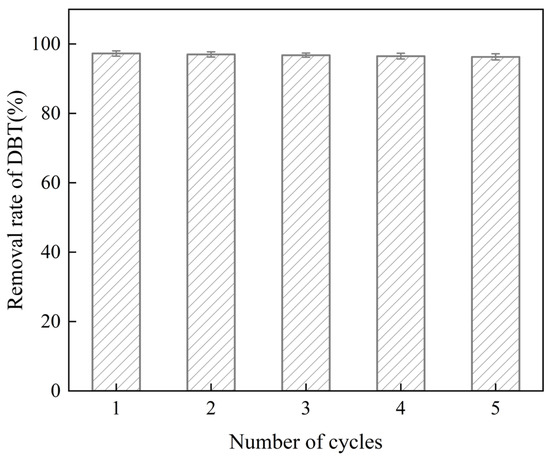
Figure 10.
Repeatability experiment of Zr@AC.
The catalytic oxidative desulfurization performances of different catalytic systems are summarized in Table 4. As shown, the Zr@AC catalyst prepared in this work achieved a DBT removal rate exceeding 97% under mild reaction conditions. Notably, this considerable desulfurization efficiency was attained within a relatively short reaction time, fully demonstrating the catalyst’s superior performance. Compared to other catalysts listed in the table, the prepared catalyst not only remains competitive in terms of removal efficiency but also exhibits considerable advantages in the mildness of reaction conditions and time efficiency. Based on the data in Figure 10 and Table 4, it can be seen that the catalyst prepared in this study not only has a good removal effect on DBT, but also maintains its performance stability after multiple reuses. Therefore, although the metal zirconium used in this study has a relatively high price, due to its abilities of being reused multiple times and the efficient removal, on average, the application cost of this catalyst is generally at a moderate level. So, it has certain economic effects and application scope in the catalytic oxidation desulfurization.

Table 4.
Performance comparison of catalytic oxidation desulfurization.
4. Conclusions
This study developed a sustainable Zr@AC catalyst, utilizing activated carbon as a low-cost support, for the oxidative removal of dibenzothiophene (DBT) from oil. The catalytic oxidation performance was systematically evaluated using a single-factor optimization approach, targeting DBT as a representative sulfur-containing furan pollutant. Five critical operational parameters (catalyst dose, oil-to-solvent ratio, temperature, reaction duration, and oil volume) were assessed. Under optimal circumstances of 0.1 g Zr@AC, 2.0 O/S, 100 °C, 50 min reaction time, and 20 mL model oil, the catalytic oxidation desulfurization system achieved a 97.3% removal efficiency of DBT. A thorough analysis using large-scale instruments (FTIR, XRD, and SEM-EDS) along with kinetic modeling demonstrated that Zr-O functional groups play a pivotal role in the Zr@AC catalyst during the catalytic oxidation process, and the reaction rate demonstrated dual dependencies on both pollutant concentration and catalyst dosage. Cycling experiments coupled with characterization analyses of pre-/post-reaction products revealed that the synthesized Zr@AC catalyst maintained robust structural integrity throughout operation cycles, exhibiting consistent desulfurization efficiency without performance degradation. These findings highlight the exceptional catalytic oxidation performance of the novel Zr@AC catalyst for desulfurization, positioning it as a sustainable and technologically promising solution for sulfur compound remediation, owing to its cost-effectiveness, technical feasibility, and superior recyclability.
Author Contributions
C.Y.: Conceptualization, Writing—original draft, Investigation, Data curation, Formal analysis, Methodology, Software. L.Z.: Investigation, Data curation, Formal analysis, Software. S.F.: Investigation, Methodology, Software. Y.C.: Investigation, Software, Data curation. J.Z.: Writing—reviewing & editing, Funding acquisition. H.H.: Conceptualization, Validation, Supervision, Funding acquisition, Writing—review & editing, Project administration. Q.Z.: Writing—review & editing, Supervision, Project administration. All authors have read and agreed to the published version of the manuscript.
Funding
This research was supported by the Guangxi Science & Technology Planning Project (grant numbers 2025GXNSFAA069822, Guike-AD25069074), National Natural Science Foundation of China (grant number 22264011), and the Scientific Research Staring Foundation of Guilin University of Technology (grant number GUTQDJJ2017072).
Institutional Review Board Statement
Not applicable.
Informed Consent Statement
Not applicable.
Data Availability Statement
The data presented in this study are available on request from the corresponding author.
Acknowledgments
The authors appreciate the Guilin Agricultural Water and Soil Resources and Environment Observation and Research Station of Guangxi (Guilin University of Technology), Collaborative Innovation Center for Water Pollution Control and Water Safety in Karst Area (Guilin University of Technology) and Guilin Lijiang River Ecology and Environment Observation and Research Station of Guangxi (Guilin University of Technology) for the support and facilitation during this research work.
Conflicts of Interest
The authors declare no conflicts of interest.
References
- Zhang, Y.; Cheng, M.; Gao, J.; Li, J. Review of the Influencing Factors of Secondary Organic Aerosol Formation and Aging Mechanism Based on Photochemical Smog Chamber Simulation Methods. J. Environ. Sci. 2023, 123, 545–559. [Google Scholar] [CrossRef] [PubMed]
- Lamonier, C. Transportation Fuels: Desulfurizing Diesel. Nat. Energy 2017, 2, 17019. [Google Scholar] [CrossRef]
- Quist, A.J.L.; Johnston, J.E. Respiratory and Nervous System Effects of a Hydrogen Sulfide Crisis in Carson, California. Sci. Total Environ. 2024, 906, 167480. [Google Scholar] [CrossRef]
- Timko, M.T.; Wang, J.A.; Burgess, J.; Kracke, P.; Gonzalez, L.; Jaye, C.; Fischer, D.A. Roles of Surface Chemistry and Structural Defects of Activated Carbons in the Oxidative Desulfurization of Benzothiophenes. Fuel 2016, 163, 223–231. [Google Scholar] [CrossRef]
- Lobo, C.B.; Correa Deza, M.A.; Arnau, G.V.; Ferrero, M.A.; Juárez Tomás, M.S. Dibenzothiophene Removal by Environmental Bacteria with Differential Accumulation of Intracellular Inorganic Polyphosphate. Bioresource Technol. 2023, 387, 129582. [Google Scholar] [CrossRef]
- Guo, S.; Yu, Q.; Zhao, S.; Tang, X.; Wang, Y.; Ma, Y.; Long, Y.; Yi, H. Research Progress on the Adsorption of Sulfocompounds in Flue Gas. Chem. Eng. J. 2023, 476, 146677. [Google Scholar] [CrossRef]
- Tran, T.Y.; Younis, S.A.; Heynderickx, P.M.; Kim, K.-H. Validation of Two Contrasting Capturing Mechanisms for Gaseous Formaldehyde Between Two Different Types of Strong Metal-Organic Framework Adsorbents. J. Hazard. Mater. 2022, 424, 127459. [Google Scholar] [CrossRef]
- Plavniece, A.; Volperts, A.; Dobele, G.; Zhurinsh, A.; Kaare, K.; Kruusenberg, I.; Kaprans, K.; Knoks, A.; Kleperis, J. Wood and Black Liquor-Based N-Doped Activated Carbon for Energy Application. Sustainability 2021, 13, 9237. [Google Scholar] [CrossRef]
- Yang, C.; de Falco, G.; Florent, M.; Bandosz, T.J. Empowering Carbon Materials Robust Gas Desulfurization Capability Through an Inclusion of Active Inorganic Phases: A Review of Recent Approaches. J. Hazard. Mater. 2022, 437, 129414. [Google Scholar] [CrossRef]
- Wang, L.; Sun, M.; Zhu, S.; Zhang, M.; Ma, Y.; Xie, D.; Li, S.; Mominou, N.; Jing, C. Cu-Ni Bimetallic Single Atoms Supported on TiO2@NG Core-Shell Material for the Removal of Dibenzothiophene Under Visible Light. Sep. Purif. Technol. 2021, 279, 119646. [Google Scholar] [CrossRef]
- Guan, X.; Wang, Y.; Cai, W. A Composite Metal-Organic Framework Material with High Selective Adsorption for Dibenzothiophene. Chin. Chem. Lett. 2019, 30, 1310–1314. [Google Scholar] [CrossRef]
- Dalvi, P.; Dey, A.; Gogate, P.R. Ultrasound-Assisted Synthesis of a N-TiO2/Fe3O4@ZnO Complex and Its Catalytic Application for Desulfurization. Sustainability 2022, 14, 16201. [Google Scholar] [CrossRef]
- Saha, B.; Vedachalam, S.; Dalai, A.K. Review on Recent Advances in Adsorptive Desulfurization. Fuel Process. Technol. 2021, 214, 106685. [Google Scholar] [CrossRef]
- Jia, L.; Song, X.; Sun, L.; Zhang, S.; Li, K.; Ning, P. Catalytic Effect of Phosphorus on SO2 Oxidation in Liquid Phase: Experimental and Theoretical Studies. Chem. Eng. J. 2022, 429, 132376. [Google Scholar] [CrossRef]
- Li, X.; Han, J.; Liu, Y.; Dou, Z.; Zhang, T. Summary of Research Progress on Industrial Flue Gas Desulfurization Technology. Sep. Purif. Technol. 2022, 281, 119849. [Google Scholar] [CrossRef]
- Niu, H.; Wang, X.-B.; Luo, J.; Liu, J.; Li, C.; Li, W.-Y.; Liang, C. C-S Cleavage of Dibenzothiophenes with or Without Steric Hindrance by the Interface Between PtSx and ZnO. Chem. Eng. J. 2023, 470, 144115. [Google Scholar] [CrossRef]
- Munnik, P.; De Jongh, P.E.; De Jong, K.P. Recent Developments in the Synthesis of Supported Catalysts. Chem. Rev. 2015, 115, 6687–6718. [Google Scholar] [CrossRef]
- Teimouri, A.; Mahmoudsalehi, M.; Salavati, H. Catalytic Oxidative Desulfurization of Dibenzothiophene Utilizing Molybdenum and Vanadium Oxides Supported on MCM-41. Int. J. Hydrogen Energ. 2018, 43, 14816–14833. [Google Scholar] [CrossRef]
- Yang, H.; Zhang, Q.; Zhang, J.; Yang, L.; Ma, Z.; Wang, L.; Li, H.; Bai, L.; Wei, D.; Wang, W.; et al. Cellulose Nanocrystal Shelled with Poly(Ionic Liquid)/Polyoxometalate Hybrid as Efficient Catalyst for Aerobic Oxidative Desulfurization. J. Colloid Interface Sci. 2019, 554, 572–579. [Google Scholar] [CrossRef]
- Nejati, F.M.; Shahhosseini, S.; Rezaee, M. Cobalt-Based Sandwich-Type Polyoxometalate Supported on Amino-Silane Decorated Magnetic Graphene Oxide: A Recoverable Catalyst for Extractive-Catalytic Oxidative Desulfurization of Model Oil. J. Environ. Chem. Eng. 2022, 10, 107949. [Google Scholar] [CrossRef]
- Heidarinejad, Z.; Dehghani, M.H.; Heidari, M.; Javedan, G.; Ali, I.; Sillanpää, M. Methods for Preparation and Activation of Activated Carbon: A Review. Environ. Chem. Lett. 2020, 18, 393–415. [Google Scholar] [CrossRef]
- Yuan, J.; Chen, J.; Wang, Z.; Yin, R.; Zhu, X.; Yang, K.; Peng, Y.; Li, J. Identification of Active Sites over Metal-Free Carbon Catalysts for Flue Gas Desulfurization. Environ. Sci. Technol. 2023, 57, 2575–2583. [Google Scholar] [CrossRef]
- Meng, B.; Cao, E.; Jia, L.; Zheng, Y.; Cui, Y. Cu-Fe Oxide Supported on Na2CO3-Modified Activated Carbon Boost H2S Removal at Low Temperature. Sep. Purif. Technol. 2025, 361, 131415. [Google Scholar] [CrossRef]
- Saleh, T.A.; AL-Hammadi, S.A.; Abdullahi, I.M.; Mustaqeem, M. Synthesis of Molybdenum Cobalt Nanocatalysts Supported on Carbon for Hydrodesulfurization of Liquid Fuels. J. Mol. Liq. 2018, 272, 715–721. [Google Scholar] [CrossRef]
- Saleh, T.A. Global Trends in Technologies and Nanomaterials for Removal of Sulfur Organic Compounds: Clean Energy and Green Environment. J. Mol. Liq. 2022, 359, 119340. [Google Scholar] [CrossRef]
- Liu, M.; Zang, Z.; Zhang, S.; Ouyang, G.; Han, R. Enhanced Fluoride Adsorption from Aqueous Solution by Zirconium (IV)-Impregnated Magnetic Chitosan Graphene Oxide. Int. J. Biol. Macromol. 2021, 182, 1759–1768. [Google Scholar] [CrossRef]
- Sun, H.; Li, L.; Zhang, H.; Yang, H.; Yang, T.; Shu, M.; Zhong, Z.; Yi, M.; Meng, B. Effect of Zirconium Modified Y Zeolite via In Situ Synthesis and Its Regulation on the Formation of Excellent NiW Catalyst for Ultra-Deep Hydrodesulfurization of 4,6-DMDBT. Chem. Eng. J. 2023, 478, 147514. [Google Scholar] [CrossRef]
- Zhang, B.; Xie, F.; Yuan, J.; Wang, L.; Deng, B. Meerwein-Ponndorf-Verley Reaction of Acetophenone over ZrO2-La2O3/MCM-41: Influence of Loading Order of ZrO2 and La2O3. Catal. Commun. 2017, 92, 46–50. [Google Scholar] [CrossRef]
- Zaboon, S.; Abid, H.R.; Yao, Z.; Gubner, R.; Wang, S.; Barifcani, A. Removal of Monoethylene Glycol from Wastewater by Using Zr-Metal Organic Frameworks. J. Colloid Interface Sci. 2018, 523, 75–85. [Google Scholar] [CrossRef]
- Liu, D.; Liu, Y.; He, H.; Liu, J.; Yang, X.; Zhang, L.; Tang, Y.; Zhu, H. Functional Bimetal/Carbon Composites Co/Zr@AC for Pesticide Atrazine Removal from Water. Molecules 2023, 28, 2071. [Google Scholar] [CrossRef]
- Zhou, X.; Zhao, C.; Yang, J.; Zhang, S. Catalytic Oxidation of Dibenzothiophene Using Cyclohexanone Peroxide. Energy Fuels 2007, 21, 7–10. [Google Scholar] [CrossRef]
- Yang, Q.; Hu, H.; Wang, S.-S. Preparation and Desulfurization Activity of Nano-CeO2/γ-Al2O3 Catalysts. Rare Met. 2018, 37, 554–560. [Google Scholar] [CrossRef]
- Yu, G.; Lu, S.; Chen, H.; Zhu, Z. Oxidative Desulfurization of Diesel Fuels with Hydrogen Peroxide in the Presence of Activated Carbon and Formic Acid. Energy Fuels 2005, 19, 447–452. [Google Scholar] [CrossRef]
- Abazari, R.; Esrafili, L.; Morsali, A.; Wu, Y.; Gao, J. PMo12@UiO-67 Nanocomposite as a Novel Non-Leaching Catalyst with Enhanced Performance Durability for Sulfur Removal from Liquid Fuels with Exceptionally Diluted Oxidant. Appl. Catal. B 2021, 283, 119582. [Google Scholar] [CrossRef]
- Dou, J.; Yu, J.; Tahmasebi, A.; Yin, F.; Gupta, S.; Li, X.; Lucas, J.; Na, C.; Wall, T. Ultrasonic-Assisted Preparation of Highly Reactive Fe-Zn Sorbents Supported on Activated-Char for Desulfurization of COG. Fuel Process. Technol. 2015, 135, 187–194. [Google Scholar] [CrossRef]
- Zang, N.; Qian, X.M.; Huang, P.; Shu, C.M. Thermal Hazard Analysis of Cyclohexanone Peroxide and Its Solutions. Thermochim. Acta 2013, 568, 175–184. [Google Scholar] [CrossRef]
- Dolatyari, A.; Ahmady, M.; Kazemi, A. A Novel Mathematical Model for Modeling Viscosity and Temperature Relationship for Dead Oils. Sci. Rep. 2024, 14, 22836. [Google Scholar] [CrossRef]
- Gao, Y.; Mirante, F.; De Castro, B.; Zhao, J.; Cunha-Silva, L.; Balula, S.S. An Effective Hybrid Heterogeneous Catalyst to Desulfurize Diesel: Peroxotungstate@Metal-Organic Framework. Molecules 2020, 25, 5494. [Google Scholar] [CrossRef] [PubMed]
- Saha, B.; Singh, A.; Sengupta, S. Study and Optimization of Adsorption of Sulfur Compounds Present in Fuel. RSC Adv. 2016, 6, 76434–76447. [Google Scholar] [CrossRef]
- Zia, Y.; Mohammadnejad, S.; Abdollahy, M. Destabilisation of Gold Cyanide Complex by Sulphur Species: A Computational Perspective. Hydrometallurgy 2020, 197, 105459. [Google Scholar] [CrossRef]
- Purohit, R.D.; Saha, S.; Tyagi, A.K. Combustion Synthesis of Nanocrystalline ZrO2 Powder: XRD, Raman Spectroscopy and TEM Studies. Mater. Sci. Eng. B 2006, 130, 57–60. [Google Scholar] [CrossRef]
- Yu, Y.; Dai, Y.; Wang, R.; Zhang, Y.; Bao, L.; Wu, Y.; Zhang, Y.; Wu, Q.; Shi, D.; Chen, K.; et al. Morphology Effect of ZrO2 on Tuning the C-H Bond Activation in Propane Dehydrogenation. ACS Catal. 2024, 14, 373–381. [Google Scholar] [CrossRef]
- Zhang, Y.; Wang, L.; Xu, Y. Effect of Doping Porous ZrO2 Solid Superacid Shell/Void/TiO2 Core Nanoparticles (ZVT) on Properties of Polyvinylidene Fluoride (PVDF) Membranes. Desalination 2015, 358, 84–93. [Google Scholar] [CrossRef]
- Huang, B.; Liu, Y.; Li, B.; Liu, S.; Zeng, G.; Zeng, Z.; Wang, X.; Ning, Q.; Zheng, B.; Yang, C. Effect of Cu(II) Ions on the Enhancement of Tetracycline Adsorption by Fe3O4@SiO2-Chitosan/Graphene Oxide Nanocomposite. Carbohyd. Polym. 2017, 157, 576–585. [Google Scholar] [CrossRef]
- Sritham, E.; Gunasekaran, S. FTIR Spectroscopic Evaluation of Sucrose-Maltodextrin-Sodium Citrate Bioglass. Food Hydrocoll. 2017, 70, 371–382. [Google Scholar] [CrossRef]
- Fauzi, N.I.M.; Fen, Y.W.; Eddin, F.B.K.; Daniyal, W.M.E.M.M. Structural and Optical Properties of Graphene Quantum Dots−Polyvinyl Alcohol Composite Thin Film and Its Potential in Plasmonic Sensing of Carbaryl. Nanomaterials 2022, 12, 4105. [Google Scholar] [CrossRef]
- Zhuravlev, Y.; Gordienko, K.; Dyagilev, D.; Luzgarev, S.; Ivanova, S.; Prosekov, A. Structural, Electronic, and Vibrational Properties of Choline Halides. Mater. Chem. Phys. 2020, 246, 122787. [Google Scholar] [CrossRef]
- Kampouraki, Z.C.; Giannakoudakis, D.A.; Triantafyllidis, K.S.; Deliyanni, E.A. Catalytic Oxidative Desulfurization of a 4,6-DMDBT Containing Model Fuel by Metal-Free Activated Carbons: The Key Role of Surface Chemistry. Green Chem. 2019, 21, 6685–6698. [Google Scholar] [CrossRef]
- Yang, C.; Zhao, K.; Cheng, Y.; Zeng, G.; Zhang, M.; Shao, J.; Lu, L. Catalytic Oxidative Desulfurization of BT and DBT from N-Octane Using Cyclohexanone Peroxide and Catalyst of Molybdenum Supported on 4A Molecular Sieve. Sep. Purif. Technol. 2016, 163, 153–161. [Google Scholar] [CrossRef]
- Meyer, J.; Wester, R. Ion-Molecule Reaction Dynamics. Annu. Rev. Phys. Chem. 2017, 68, 333–353. [Google Scholar] [CrossRef]
- Saleh, T.A.; Sulaiman, K.O.; AL-Hammadi, S.A.; Dafalla, H.; Danmaliki, G.I. Adsorptive Desulfurization of Thiophene, Benzothiophene and Dibenzothiophene over Activated Carbon Manganese Oxide Nanocomposite: With Column System Evaluation. J. Clean. Prod. 2017, 154, 401–412. [Google Scholar] [CrossRef]
- Chen, X.; Guo, Y.; Zhang, H.; Cheng, F.; Jiao, Z. Coke Powder Improving the Performance of Desulfurized Activated Carbon from the Cyclic Thermal Regeneration. Chem. Eng. J. 2022, 448, 137459. [Google Scholar] [CrossRef]
- Li, Q.; Hou, Y.; Han, X.; Wang, J.; Liu, Y.; Xiang, N.; Huang, Z. Promotional Effect of Cyclic Desulfurization and Regeneration for Selective Catalytic Reduction of NO by NH3 over Activated Carbon. J. Clean. Prod. 2020, 249, 119392. [Google Scholar] [CrossRef]
- Zhang, G.; Yang, F.; Yang, W.; Li, Y. N-Doped Carbon Nanotube Encapsulated nZVI as a High-Performance Bifunctional Catalyst for Oxidative Desulfurization. Particuology 2023, 81, 109–118. [Google Scholar] [CrossRef]
- Li, J.; Liu, D.; Jiang, X.; Zhu, M.; Dai, B. Triazine-Based Covalent Organic Polymer as a High Aerobic Oxidative Desulfurization Performance Catalyst Under Mild Reaction Conditions. Mol. Catal. 2023, 547, 113326. [Google Scholar] [CrossRef]
- Feng, Z.; Zhu, Y.; Zhou, Q.; Wu, Y.; Wu, T. Magnetic WO3/Fe3O4 as Catalyst for Deep Oxidative Desulfurization of Model Oil. Mater. Sci. Eng. B 2019, 240, 85–91. [Google Scholar] [CrossRef]
- Yin, J.; Fu, W.; Zhang, J.; Liu, X.; Zhang, X.; Wang, C.; He, J.; Jiang, W.; Li, H.; Li, H. UiO-66(Zr)-Based Porous Ionic Liquids for Highly Efficient Extraction Coupled Catalytic Oxidative Desulfurization. Chem. Eng. J. 2023, 470, 144290. [Google Scholar] [CrossRef]
Disclaimer/Publisher’s Note: The statements, opinions and data contained in all publications are solely those of the individual author(s) and contributor(s) and not of MDPI and/or the editor(s). MDPI and/or the editor(s) disclaim responsibility for any injury to people or property resulting from any ideas, methods, instructions or products referred to in the content. |
© 2025 by the authors. Licensee MDPI, Basel, Switzerland. This article is an open access article distributed under the terms and conditions of the Creative Commons Attribution (CC BY) license (https://creativecommons.org/licenses/by/4.0/).